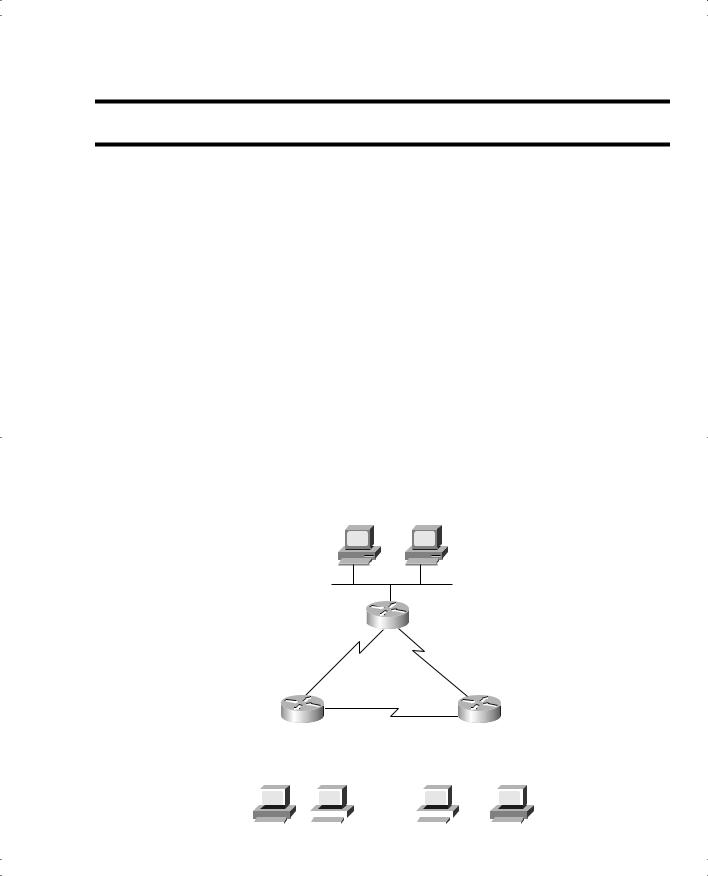
- •Warning and Disclaimer
- •Feedback Information
- •Trademark Acknowledgments
- •About the Author
- •About the Technical Reviewers
- •Dedication
- •Acknowledgments
- •Contents at a Glance
- •Contents
- •Icons Used in This Book
- •Command Syntax Conventions
- •Cisco’s Motivation: Certifying Partners
- •Format of the CCNA Exams
- •What’s on the CCNA Exams
- •ICND Exam Topics
- •Cross-Reference Between Exam Topics and Book Parts
- •CCNA Exam Topics
- •INTRO and ICND Course Outlines
- •Objectives and Methods
- •Book Features
- •How This Book Is Organized
- •Part I: LAN Switching
- •Part II: TCP/IP
- •Part III: Wide-Area Networks
- •Part IV: Network Security
- •Part V: Final Preparation
- •Part VI: Appendixes
- •How to Use These Books to Prepare for the CCNA Exam
- •For More Information
- •Part I: LAN Switching
- •“Do I Know This Already?” Quiz
- •Foundation Topics
- •Brief Review of LAN Switching
- •The Forward-Versus-Filter Decision
- •How Switches Learn MAC Addresses
- •Forwarding Unknown Unicasts and Broadcasts
- •LAN Switch Logic Summary
- •Basic Switch Operation
- •Foundation Summary
- •Spanning Tree Protocol
- •“Do I Know This Already?” Quiz
- •Foundation Topics
- •Spanning Tree Protocol
- •What IEEE 802.1d Spanning Tree Does
- •How Spanning Tree Works
- •Electing the Root and Discovering Root Ports and Designated Ports
- •Reacting to Changes in the Network
- •Spanning Tree Protocol Summary
- •Optional STP Features
- •EtherChannel
- •PortFast
- •Rapid Spanning Tree (IEEE 802.1w)
- •RSTP Link and Edge Types
- •RSTP Port States
- •RSTP Port Roles
- •RSTP Convergence
- •Edge-Type Behavior and PortFast
- •Link-Type Shared
- •Link-Type Point-to-Point
- •An Example of Speedy RSTP Convergence
- •Basic STP show Commands
- •Changing STP Port Costs and Bridge Priority
- •Foundation Summary
- •Foundation Summary
- •Virtual LANs and Trunking
- •“Do I Know This Already?” Quiz
- •Foundation Topics
- •Review of Virtual LAN Concepts
- •Trunking with ISL and 802.1Q
- •ISL and 802.1Q Compared
- •VLAN Trunking Protocol (VTP)
- •How VTP Works
- •VTP Pruning
- •Foundation Summary
- •Part II: TCP/IP
- •IP Addressing and Subnetting
- •“Do I Know This Already?” Quiz
- •Foundation Topics
- •IP Addressing Review
- •IP Subnetting
- •Analyzing and Interpreting IP Addresses and Subnets
- •Math Operations Used to Answer Subnetting Questions
- •Converting IP Addresses from Decimal to Binary and Back Again
- •The Boolean AND Operation
- •How Many Hosts and How Many Subnets?
- •What Is the Subnet Number, and What Are the IP Addresses in the Subnet?
- •Finding the Subnet Number
- •Finding the Subnet Broadcast Address
- •Finding the Range of Valid IP Addresses in a Subnet
- •Finding the Answers Without Using Binary
- •Easier Math with Easy Masks
- •Which Subnet Masks Meet the Stated Design Requirements?
- •What Are the Other Subnet Numbers?
- •Foundation Summary
- •“Do I Know This Already?” Quiz
- •Foundation Topics
- •Extended ping Command
- •Distance Vector Concepts
- •Distance Vector Loop-Avoidance Features
- •Route Poisoning
- •Split Horizon
- •Split Horizon with Poison Reverse
- •Hold-Down Timer
- •Triggered (Flash) Updates
- •RIP and IGRP
- •IGRP Metrics
- •Examination of RIP and IGRP debug and show Commands
- •Issues When Multiple Routes to the Same Subnet Exist
- •Administrative Distance
- •Foundation Summary
- •“Do I Know This Already?” Quiz
- •Foundation Topics
- •Link-State Routing Protocol and OSPF Concepts
- •Steady-State Operation
- •Loop Avoidance
- •Scaling OSPF Through Hierarchical Design
- •OSPF Areas
- •Stub Areas
- •Summary: Comparing Link-State and OSPF to Distance Vector Protocols
- •Balanced Hybrid Routing Protocol and EIGRP Concepts
- •EIGRP Loop Avoidance
- •EIGRP Summary
- •Foundation Summary
- •“Do I Know This Already?” Quiz
- •Foundation Topics
- •Route Summarization and Variable-Length Subnet Masks
- •Route Summarization Concepts
- •VLSM
- •Route Summarization Strategies
- •Sample “Best” Summary on Seville
- •Sample “Best” Summary on Yosemite
- •Classless Routing Protocols and Classless Routing
- •Classless and Classful Routing Protocols
- •Autosummarization
- •Classful and Classless Routing
- •Default Routes
- •Classless Routing
- •Foundation Summary
- •Advanced TCP/IP Topics
- •“Do I Know This Already?” Quiz
- •Foundation Topics
- •Scaling the IP Address Space for the Internet
- •CIDR
- •Private Addressing
- •Network Address Translation
- •Static NAT
- •Dynamic NAT
- •Overloading NAT with Port Address Translation (PAT)
- •Translating Overlapping Addresses
- •Miscellaneous TCP/IP Topics
- •Internet Control Message Protocol (ICMP)
- •ICMP Echo Request and Echo Reply
- •Destination Unreachable ICMP Message
- •Time Exceeded ICMP Message
- •Redirect ICMP Message
- •Secondary IP Addressing
- •FTP and TFTP
- •TFTP
- •MTU and Fragmentation
- •Foundation Summary
- •Part III: Wide-Area Networks
- •“Do I Know This Already?” Quiz
- •Foundation Topics
- •Review of WAN Basics
- •Physical Components of Point-to-Point Leased Lines
- •Data-Link Protocols for Point-to-Point Leased Lines
- •HDLC and PPP Compared
- •Looped Link Detection
- •Enhanced Error Detection
- •Authentication Over WAN Links
- •PAP and CHAP Authentication
- •Foundation Summary
- •“Do I Know This Already?” Quiz
- •Foundation Topics
- •ISDN Protocols and Design
- •Typical Uses of ISDN
- •ISDN Channels
- •ISDN Protocols
- •ISDN BRI Function Groups and Reference Points
- •ISDN PRI Function Groups and Reference Points
- •BRI and PRI Encoding and Framing
- •PRI Encoding
- •PRI Framing
- •BRI Framing and Encoding
- •DDR Step 1: Routing Packets Out the Interface to Be Dialed
- •DDR Step 2: Determining the Subset of the Packets That Trigger the Dialing Process
- •DDR Step 3: Dialing (Signaling)
- •DDR Step 4: Determining When the Connection Is Terminated
- •ISDN and DDR show and debug Commands
- •Multilink PPP
- •Foundation Summary
- •Frame Relay
- •“Do I Know This Already?” Quiz
- •Foundation Topics
- •Frame Relay Protocols
- •Frame Relay Standards
- •Virtual Circuits
- •LMI and Encapsulation Types
- •DLCI Addressing Details
- •Network Layer Concerns with Frame Relay
- •Layer 3 Addressing with Frame Relay
- •Frame Relay Layer 3 Addressing: One Subnet Containing All Frame Relay DTEs
- •Frame Relay Layer 3 Addressing: One Subnet Per VC
- •Frame Relay Layer 3 Addressing: Hybrid Approach
- •Broadcast Handling
- •Frame Relay Service Interworking
- •A Fully-Meshed Network with One IP Subnet
- •Frame Relay Address Mapping
- •A Partially-Meshed Network with One IP Subnet Per VC
- •A Partially-Meshed Network with Some Fully-Meshed Parts
- •Foundation Summary
- •Part IV: Network Security
- •IP Access Control List Security
- •“Do I Know This Already?” Quiz
- •Foundation Topics
- •Standard IP Access Control Lists
- •IP Standard ACL Concepts
- •Wildcard Masks
- •Standard IP ACL: Example 2
- •Extended IP Access Control Lists
- •Extended IP ACL Concepts
- •Extended IP Access Lists: Example 1
- •Extended IP Access Lists: Example 2
- •Miscellaneous ACL Topics
- •Named IP Access Lists
- •Controlling Telnet Access with ACLs
- •ACL Implementation Considerations
- •Foundation Summary
- •Part V: Final Preparation
- •Final Preparation
- •Suggestions for Final Preparation
- •Preparing for the Exam Experience
- •Final Lab Scenarios
- •Scenario 1
- •Scenario 1, Part A: Planning
- •Solutions to Scenario 1, Part A: Planning
- •Scenario 2
- •Scenario 2, Part A: Planning
- •Solutions to Scenario 2, Part A: Planning
- •Part VI: Appendixes
- •Glossary
- •Answers to the “Do I Know This Already?” Quizzes and Q&A Questions
- •Chapter 1
- •“Do I Know This Already?” Quiz
- •Chapter 2
- •“Do I Know This Already?” Quiz
- •Chapter 3
- •“Do I Know This Already?” Quiz
- •Chapter 4
- •“Do I Know This Already?” Quiz
- •Chapter 5
- •“Do I Know This Already?” Quiz
- •Chapter 6
- •“Do I Know This Already?” Quiz
- •Chapter 7
- •“Do I Know This Already?” Quiz
- •Chapter 8
- •“Do I Know This Already?” Quiz
- •Chapter 9
- •“Do I Know This Already?” Quiz
- •Chapter 10
- •“Do I Know This Already?” Quiz
- •Chapter 11
- •“Do I Know This Already?” Quiz
- •Chapter 12
- •“Do I Know This Already?” Quiz
- •Using the Simulation Software for the Hands-on Exercises
- •Accessing NetSim from the CD
- •Hands-on Exercises Available with NetSim
- •Scenarios
- •Labs
- •Listing of the Hands-on Exercises
- •How You Should Proceed with NetSim
- •Considerations When Using NetSim
- •Routing Protocol Overview
- •Comparing and Contrasting IP Routing Protocols
- •Routing Through the Internet with the Border Gateway Protocol
- •RIP Version 2
- •The Integrated IS-IS Link State Routing Protocol
- •Summary of Interior Routing Protocols
- •Numbering Ports (Interfaces)

Configuring and Testing Static Routes 145
Foundation Topics
Configuring and Testing Static Routes
The purpose of configuring static routes, as well as RIP and IGRP, is to add routes to a router’s routing table. RIP and IGRP do so automatically. In fact, after you read all the conceptual material in this chapter, the actual RIP and IGRP configuration can be a little anticlimactic. In most networks, all you need are two configuration commands to configure RIP or IGRP. You don’t have to understand how they work—they just work. You need to understand both static routing and the distance vector concepts behind RIP and IGRP.
Static routing consists of individual configuration commands that define a route to a router. A router can forward packets only to subnets in its routing table. The router always knows about directly connected routes—routes to subnets off interfaces that have an “up and up” status. By adding static routes, a router can be told how to forward packets to subnets that are not attached to it.
Adding static routes to a router is relatively easy. To see the need, and to see the configuration, look at Example 5-1, which shows two ping commands testing IP connectivity from Albuquerque to Yosemite (see Figure 5-1).
Figure 5-1 Sample Network Used in Static Route Configuration Examples
Bugs Daffy
10.1.1.0
10.1.1.251
10.1.128.251
s0
|
|
|
0 |
|
|
. |
|
|
|
.128 |
|
|
|
1 |
|
|
. |
|
|
10.1.128.252 |
10 |
|
|
|
|
|
|
s0 |
|
|
|
Albuquerque |
|
|
s1 |
10.1.130.251 |
|
|
10 |
|
|
. |
|
|
1 |
|
|
. |
|
|
130 |
10.1.130.253 |
|
. |
|
|
0 |
|
|
|
s0 |
|
|
|
|
|
|
|
|
|
|
|
|
|
|
|
|
10.1.129.0 |
|
|
|
|
|
|
|
|
|
|
|
|
|
||
Yosemite |
|
|
s1 |
|
|
|
|
|
s1 |
|
|
|
Seville |
||||||||||||||||||
|
10.1.129.252 |
|
|
|
|
|
|
|
|||||||||||||||||||||||
10.1.2.252 |
|
|
|
|
|
|
|
|
|
10.1.129.253 |
|
10.1.3.253 |
|||||||||||||||||||
10.1.2.0 |
|
|
|
|
|
|
|
|
|
|
|
|
|
|
|
|
|
|
|
|
|
10.1.3.0 |
|||||||||
|
|
|
|
|
|
|
|
|
|
|
|
|
|
|
|
|
|
|
|
|
|
|
|
|
|
|
|
|
|
|
|
|
|
|
|
|
|
|
|
|
|
|
|
|
|
|
|
|
|
|
|
|
|
|
|
|
|
|
|
|
|
|
|
|
|
|
|
|
|
|
|
|
|
|
|
|
|
|
|
|
|
|
|
|
|
|
|
|
|
|
|
|
|
|
|
|
|
|
|
|
|
|
|
|
|
|
|
|
|
|
|
|
|
|
|
|
|
|
|
|
|
|
|
|
|
|
|
|
|
|
|
|
|
|
|
|
|
|
|
|
|
|
|
|
|
|
|
|
|
|
|
|
|
|
|
|
|
|
|
|
|
|
|
|
|
|
|
|
|
|
|
|
|
|
|
|
|
|
|
|
|
|
|
|
|
|
|
|
|
|
|
Sam |
Emma |
Elmer |
Red |

146 Chapter 5: RIP, IGRP, and Static Route Concepts and Configuration
Example 5-1 Albuquerque Router EXEC Commands with Only Connected Routers
Albuquerque#show ip route
Codes: C - connected, S - static, I - IGRP, R - RIP, M - mobile, B - BGP
D - EIGRP, EX - EIGRP external, O - OSPF, IA - OSPF inter area
N1 - OSPF NSSA external type 1, N2 - OSPF NSSA external type 2
E1 - OSPF external type 1, E2 - OSPF external type 2, E - EGP
i - IS-IS, L1 - IS-IS level-1, L2 - IS-IS level-2, ia - IS-IS inter area * - candidate default, U - per-user static route, o - ODR
P - periodic downloaded static route
Gateway of last resort is not set
10.0.0.0/24 is subnetted, 3 subnets
C10.1.1.0 is directly connected, Ethernet0
C10.1.130.0 is directly connected, Serial1
C10.1.128.0 is directly connected, Serial0 Albuquerque#ping 10.1.128.252
Type escape sequence to abort.
Sending 5, 100-byte ICMP Echos to 10.1.128.252, timeout is 2 seconds:
!!!!!
Success rate is 100 percent (5/5), round-trip min/avg/max = 4/4/8 ms
Albuquerque#ping 10.1.2.252
Type escape sequence to abort.
Sending 5, 100-byte ICMP Echos to 10.1.2.252, timeout is 2 seconds:
.....
Success rate is 0 percent (0/5)
The ping command sends an ICMP echo request packet to the stated destination address. The TCP/IP software at the destination then replies to the ping echo request packet with a similar packet, called an ICMP echo reply. The ping command sends the first packet and waits on the response. If a response is received, the command displays a “!”. If no response is received within the default timeout of 2 seconds, the ping command displays a “.”. The IOS ping command sends 5 of these packets by default.
In Example 5-1, the ping 10.1.128.2 command works, but the ping 10.1.2.252 command does not. The first ping command works because Albuquerque has a route to the subnet in which 10.1.128.2 resides (subnet 10.1.128.0). However, the ping to 10.1.2.252 does not work, because the subnet in which 10.1.2.252 resides, subnet 10.1.2.0, is not connected to Albuquerque, so Albuquerque does not have a route to that subnet. So, none of the five ping packets works, resulting in five periods in the output of the ping command.

Configuring and Testing Static Routes 147
Configuring Static Routes
One simple solution to the failure of the ping command is to enable an IP routing protocol on all three routers. In fact, in a real network, that is the most likely solution. As an alternative, you can configure static routes. Many networks have a few static routes, so you need to configure them occasionally. Example 5-2 shows the ip route command on Albuquerque, which adds static routes and makes the failed ping from Example 5-1 work.
Example 5-2 Static Routes Added to Albuquerque
ip route 10.1.2.0 255.255.255.0 10.1.128.252
ip route 10.1.3.0 255.255.255.0 10.1.130.253
The ip route commands supply the subnet number and the next-hop IP address. One ip route command defines a route to 10.1.2.0 (mask 255.255.255.0), which is located off Yosemite, so the next-hop IP address as configured on Albuquerque is 10.1.128.252, which is Yosemite’s Serial0 IP address. Similarly, a route to 10.1.3.0, the subnet off Seville, points to Seville’s Serial0 IP address, 10.1.130.253. Note that the next-hop IP address is an IP address in a directly connected subnet—the goal is to define the next router to send the packet to. Now Albuquerque can forward packets to these two subnets.
You can configure static routes in a couple different ways. With point-to-point serial links, you can also configure the outgoing interface instead of the next-hop IP address. For instance, you could have configured ip route 10.1.2.0 255.255.255.0 serial0 for the first route in Example 5-2.
Unfortunately, adding these two static routes to Albuquerque does not solve all the network’s routing problems. The static routes help Albuquerque deliver packets to these two subnets, but the other two routers don’t have enough routing information to forward packets back toward Albuquerque. For instance, PC Bugs cannot ping PC Sam in this network. The problem is that although Albuquerque has a route to subnet 10.1.2.0, where Sam resides, Yosemite does not have a route to 10.1.1.0, where Bugs resides. The ping request packet goes from Bugs to Sam correctly, but Sam’s ping response packet cannot be routed by the Yosemite router back through Albuquerque to Bugs, so the ping fails.
Extended ping Command
In real life, you might not be able to find a user, like Bugs, to ask to test your network by pinging. So you can use the extended ping command on a router to test routing in the same way a ping from Bugs to Sam tests routing. Example 5-3 shows Albuquerque with the working ping 10.1.2.252 command, but with an extended ping command that works

148 Chapter 5: RIP, IGRP, and Static Route Concepts and Configuration
similarly to a ping from Bugs to Sam—a ping that fails in this case (only the two static routes from Example 5-2 have been added at this point).
Example 5-3 Albuquerque: Working Ping After Adding Default Routes, Plus Failing Extended ping Command
Albuquerque#show ip route
Codes: C - connected, S - static, I - IGRP, R - RIP, M - mobile, B - BGP
D - EIGRP, EX - EIGRP external, O - OSPF, IA - OSPF inter area
N1 - OSPF NSSA external type 1, N2 - OSPF NSSA external type 2
E1 - OSPF external type 1, E2 - OSPF external type 2, E - EGP
i - IS-IS, L1 - IS-IS level-1, L2 - IS-IS level-2, ia - IS-IS inter area * - candidate default, U - per-user static route, o - ODR
P - periodic downloaded static route
Gateway of last resort is not set
10.0.0.0/24 is subnetted, 5 subnets
S10.1.3.0 [1/0] via 10.1.130.253
S10.1.2.0 [1/0] via 10.1.128.252
C10.1.1.0 is directly connected, Ethernet0
C10.1.130.0 is directly connected, Serial1
C10.1.128.0 is directly connected, Serial0 Albuquerque#ping 10.1.2.252
Type escape sequence to abort.
Sending 5, 100-byte ICMP Echos to 10.1.2.252, timeout is 2 seconds:
!!!!!
Success rate is 100 percent (5/5), round-trip min/avg/max = 4/4/8 ms
Albuquerque#ping
Protocol [ip]:
Target IP address: 10.1.2.252
Repeat count [5]:
Datagram size [100]:
Timeout in seconds [2]:
Extended commands [n]: y
Source address or interface: 10.1.1.251
Type of service [0]:
Set DF bit in IP header? [no]:
Validate reply data? [no]:
Data pattern [0xABCD]:
Loose, Strict, Record, Timestamp, Verbose[none]:
Sweep range of sizes [n]:
Type escape sequence to abort.
Sending 5, 100-byte ICMP Echos to 10.1.2.252, timeout is 2 seconds:
. . . . .
Success rate is 0 percent (0/5)

Configuring and Testing Static Routes 149
The simple ping 10.1.2.252 command works for one obvious reason and one not-so-obvious reason. First, Albuquerque can forward a packet to subnet 10.1.2.0 because of the static route. The return packet, sent by Yosemite, is sent to address 10.1.128.251—Albuquerque’s Serial0 IP address. Why? Well, the following points are true about the ping command on a Cisco router:
■The Cisco ping command uses, by default, the output interface’s IP address as the packet’s source address unless otherwise specified in an extended ping. The first ping in Example 5-3 uses a source of 10.1.128.251, because the route used to send the packet to 10.1.2.252 points out interface Serial0, whose IP address is 10.1.128.251.
■Ping response packets reverse the IP addresses used in the received ping request to which they are responding. So, in this example, Yosemite uses 10.1.128.251 as the destination address and 10.1.2.252 as the source IP address.
Because the ping command on Albuquerque uses 10.1.128.251 as the packet’s source address, Yosemite can send back a response to 10.1.128.251, because Yosemite happens to have a route to 10.1.128.0.
When you troubleshoot this network, you can use the extended ping command to act like you issued a ping from a computer on that subnet, without having to call a user and ask to enter a ping command for you on the PC. The extended version of the ping command can be used to refine the problem’s underlying cause by changing several details of what the ping command sends in its request. In fact, when a ping from a router works, but a ping from a host does not, the extended ping could help you re-create the problem without needing to work with the end user on the phone.
For instance, in Example 5-3, the extended ping command on Albuquerque sends a packet from 10.1.1.251 (Albuquerque’s Ethernet) to 10.1.2.252 (Yosemite’s Ethernet). According to the output, no response was received by Albuquerque. Normally, the ping would be sourced from the IP address of the outgoing interface. With the use of the extended ping source address option, the source IP address of the echo packet is set to Albuquerque’s Ethernet IP address, 10.1.1.251. Because the ICMP echo generated by the extended ping is sourced from an address in subnet 10.1.1.0, the packet looks more like a packet from an end user in that subnet. Yosemite builds a reply, with destination 10.1.1.251, but it does not have a route to that subnet. So Yosemite cannot send the ping reply packet back to Albuquerque.
To solve this problem, all routers could be configured to use a routing protocol. Alternatively, you could simply define static routes on all the routers in the network.
